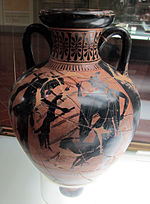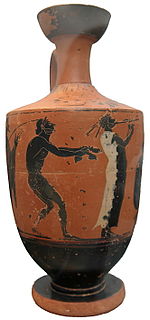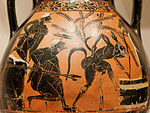The Acheloos Painter, active around 525 - 500 BCE in Athens, was a vase painter of the black-figure style. His scenes were like those of the Leagros Group; however, unlike their work, his themes are comic episodes, not unlike modern cartoons. Herakles was a favorite topic, as were banqueting scenes. His banqueters were portrayed satirically: overweight, aging, huge, jutting noses, and so on. The heroic is made anti-heroic by parody. His preferred vase forms are amporae and hydriae.[1]
Name vase
He received his name from a representation of a fight between the river god, Acheloos, and Heracles, on formerly Amphora F 1851 in the Berlin Antique collection,[2] now missing.[1] In this comic depiction, the screaming and frightened river god, in the form of a horned centaur, is being kept from escaping by an unflustered Herakles pulling him back by the horns. Hermes, stock messenger of the gods, sits at ease. His long, projecting beard juts out parallel to his long, projecting nose. In the heroic scenes of Greek mythology, a hero ought to be victorious over awful and implacable monsters according the will of the divine gods. In this scene and others like it the hero demeans himself with a craven and ridiculous monster while the caricature of divinity slumps over in a state of ennui.[3] "Nonsense inscriptions" have nothing to say.
In an unrelated scene on the opposite side, a hoplite and an archer say goodbye to their aged parents. The wrinkles are shown in the mother's neck. The hoplite's shield covers him up to his nose. On it is emblazoned an isolated running leg with a naked buttock. A dog sniffs at the hoplite's groin region.
Select works
Notes
Campbell, Gordon, ed. (2007). "Acheloos Painter". The Grove Encyclopedia of Classical Art and Architecture. Volume I: Abacus – Lyson and Kallikles Tomb. New York: Oxford University Press. "untraced; ex-Berlin"
"Berlin F 1851 (Vase)". Art & Archaeology Artifact Browser, Perseus Digital Library. Tufts University. Retrieved 30 June 2012.
Cohen, Beth (2000). Not the classical ideal: Athens and the construction of the other in Greek art. Leiden; Boston: Brill. p. 86.
Additional references
Beazley, J D (1986). The development of Attic black-figure. Sather classical lectures, v. 24. Berkeley: University of California Press. p. 79.
External links
"3 Vases whose Painter is Acheloos Painter". Art & Archaeology Artifact Browser, Perseus Digital Library. Tufts University. Retrieved 20 June 2012.
Retrieved from "http://en.wikipedia.org/"
All text is available under the terms of the GNU Free Documentation License
| Ancient Greece
Science, Technology , Medicine , Warfare, , Biographies , Life , Cities/Places/Maps , Arts , Literature , Philosophy ,Olympics, Mythology , History , Images Medieval Greece / Byzantine Empire Science, Technology, Arts, , Warfare , Literature, Biographies, Icons, History Modern Greece Cities, Islands, Regions, Fauna/Flora ,Biographies , History , Warfare, Science/Technology, Literature, Music , Arts , Film/Actors , Sport , Fashion --- |




